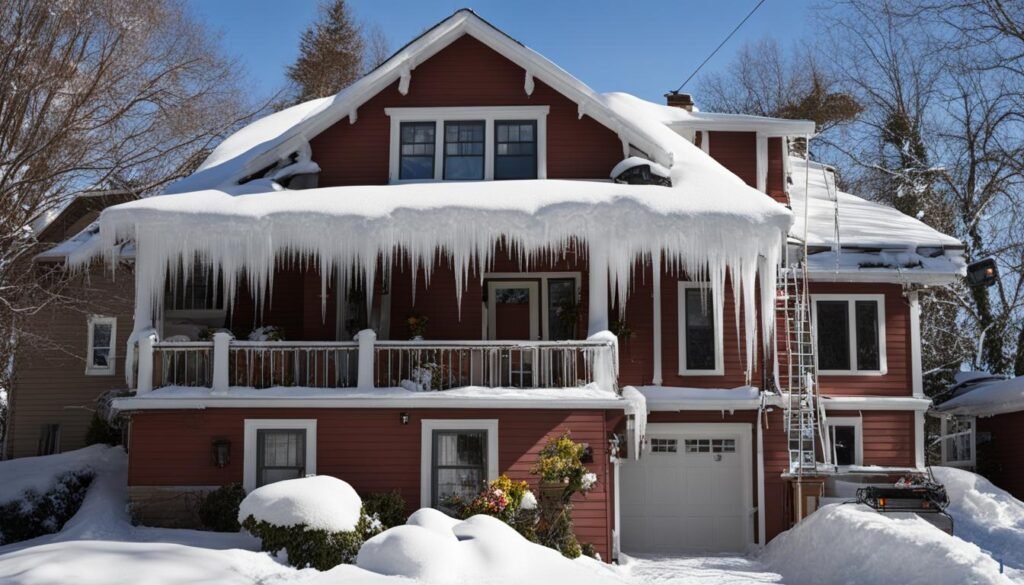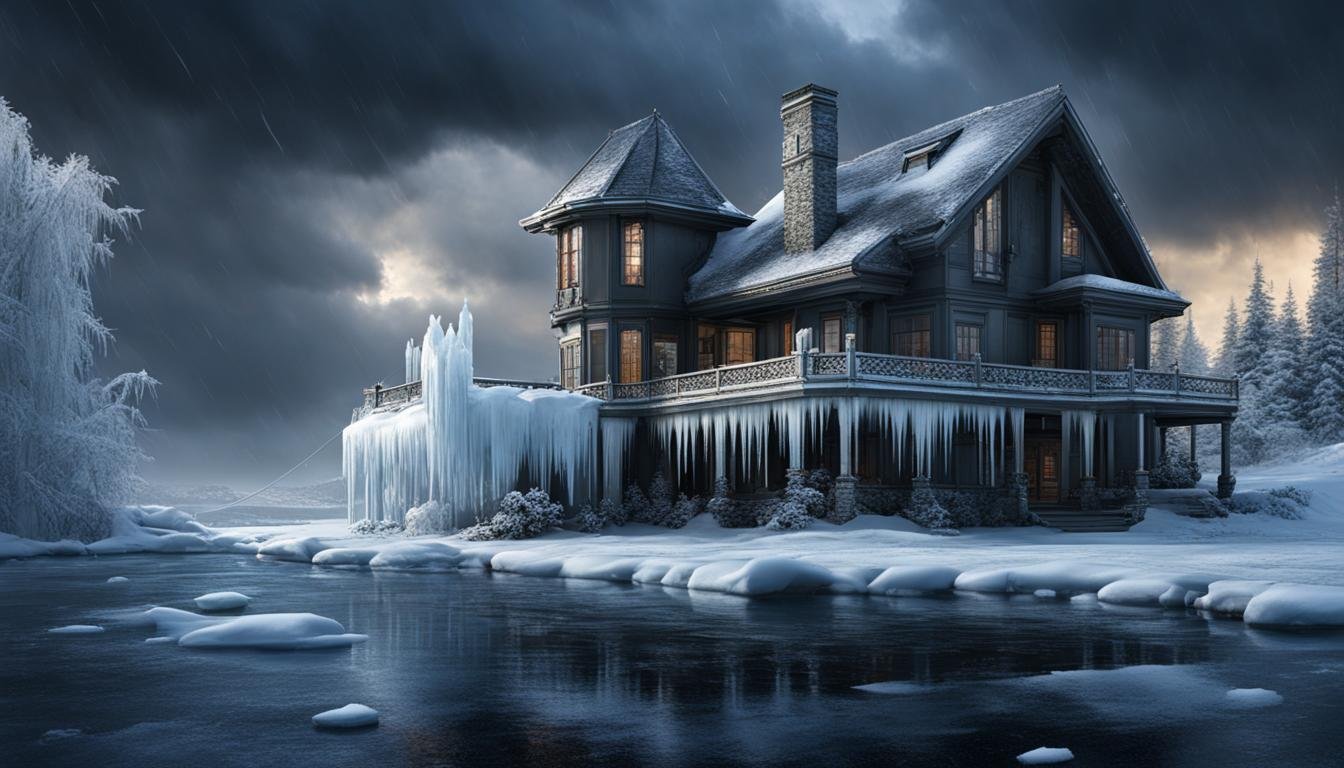As the cozy winter season approaches, it’s important to remember that winter can also bring harsh weather conditions that pose a threat to our homes. From burst pipes to iced rooftops, winter weather can wreak havoc. Preparing your home for winter can help you mitigate damage and avoid costly repair bills.
Key Takeaways:
- Protect your home from winter water damage by taking proactive measures.
- Insulate your home to keep it warm and reduce energy costs.
- Perform regular maintenance to ensure your home is ready for the winter season.
- Weatherproof your home’s exterior to prevent damage from snow, ice, and freezing temperatures.
- Take steps to prevent frozen pipes and water damage.
How to Prepare Your Home’s Exterior for Winter
Your home’s exterior is the first line of defense against harsh winter weather. Taking proactive steps to winterize your home can help prevent potential damage and ensure the safety and comfort of your household. Here are some essential tips to prepare your home’s exterior for the winter season:
- Clean your gutters: Before winter arrives, it’s important to clean out your gutters to remove any debris or blockages. This helps prevent water from overflowing and causing damage to your roof and foundation. By keeping your gutters clean, you can also prevent ice dams, which can lead to leaks and water damage inside your home.
- Trim back tree branches: Inspect the surrounding trees and trim back any branches that are close to or overhang your home. Winter storms and heavy snow can cause branches to break and fall, potentially damaging your roof, windows, or siding. By trimming back the branches, you reduce the risk of such damage.
- Re-caulk windows and doors: Check the caulk around your windows and doors and replace any damaged or worn-out caulking. This will help seal gaps and prevent drafts, keeping your home warm and reducing energy consumption. Additionally, it helps prevent moisture from seeping into your home, which can lead to mold growth and water damage.
- Get your roof inspected: Schedule a professional roof inspection before the winter season begins. A qualified roofer can identify any existing issues that need to be addressed, such as loose or missing shingles, damaged flashing, or weakened areas. By addressing these problems early on, you can prevent potential leaks or structural damage during winter storms.
- Get your chimney inspected: If you have a fireplace or wood-burning stove, it’s essential to have your chimney inspected and cleaned before using it during the winter. A professional chimney sweep can remove creosote buildup, identify any cracks or blockages, and ensure that the chimney is functioning properly. This helps prevent chimney fires and carbon monoxide poisoning.
- Protect against ice dams: Ice dams occur when snow melts on the warmer parts of your roof and refreezes near the colder eaves. This can lead to water seeping under the shingles and causing damage to the roof and interior of your home. To protect against ice dams, make sure your attic is properly insulated and ventilated. This helps maintain a consistent roof temperature and prevents snow from melting unevenly.
By following these steps to prepare your home’s exterior for winter, you can ensure its durability, protect against potential damage, and maintain a warm and comfortable living environment throughout the cold season.

| Preparation Step | Description |
|---|---|
| Clean your gutters | Remove debris and blockages to prevent water overflow and ice dams. |
| Trim back tree branches | Reduce the risk of roof and siding damage caused by falling branches. |
| Re-caulk windows and doors | Seal gaps to prevent drafts, moisture infiltration, and energy loss. |
| Get your roof inspected | Address any existing roof issues to prevent leaks and structural damage. |
| Get your chimney inspected | Ensure a safe and efficient fireplace operation by detecting and resolving potential chimney problems. |
| Protect against ice dams | Properly insulate and ventilate your attic to prevent uneven snow melting and water seepage. |
How to Prepare Your Home’s Interior for Winter
With the exterior of your home protected from the harsh winter weather, it’s time to turn your attention to the interior. By taking a few key steps, you can ensure that your home is cozy, comfortable, and well-prepared for the colder months ahead.
Inspect Home Systems
Before winter sets in, it’s important to inspect your home’s systems to ensure they are in good working order. Take the time to check your HVAC system, plumbing, and electrical components. This will help you identify any issues that need to be addressed before the colder weather arrives, preventing potential breakdowns or hazards that could leave you without heat or hot water on a chilly winter day.
Reverse Ceiling Fans
A simple yet effective way to enhance the warmth in your home is by reversing your ceiling fans. By changing the direction of the fan blades to rotate clockwise, you can help circulate warm air that has risen to the ceiling and push it back down into the room. This can make your space feel warmer and more comfortable, reducing your reliance on heating systems and saving you money on energy bills.
Enhance Home Insulation
One of the most effective ways to keep your home warm during the winter is by enhancing its insulation. Start by sealing drafts around windows and doors using weatherstrips or caulk. This will help prevent cold air from entering and warm air from escaping, significantly reducing heat loss. Adding extra insulation in the attic, walls, and floors can further enhance your home’s ability to retain heat and improve energy efficiency.
Seal Drafts
Drafts can significantly impact the comfort and energy efficiency of your home during the winter months. Take the time to locate and seal any drafts around windows, doors, outlets, and other areas where cold air may enter. This can be done using weatherstrips, door sweeps, or window sealant. Sealing drafts will not only keep your home warmer but also save you money on heating costs in the long run.
Insulate Pipes
Freezing temperatures can cause pipes to burst, leading to costly water damage. To protect your pipes, insulate them using pipe insulation sleeves or heat tape. Pay special attention to pipes located in unheated areas such as basements, crawl spaces, or attics. By insulating your pipes, you can prevent freezing and potential water damage, ensuring that your home remains safe and dry throughout the winter.
Use Space Heaters Safely
If you plan on using space heaters to supplement your home’s heating system, it’s essential to follow safety guidelines. Keep space heaters at least three feet away from flammable materials such as curtains or furniture. Never leave a space heater unattended and be sure to turn it off when leaving the room or going to bed. Additionally, avoid using extension cords with space heaters, as they can overheat and pose a fire hazard.
| Tips for Preparing Your Home’s Interior for Winter |
|---|
| Inspect home systems (HVAC, plumbing, electrical) to ensure they are in good working order. |
| Reverse ceiling fans to circulate warm air and improve heating efficiency. |
| Enhance home insulation by sealing drafts and adding extra insulation where necessary. |
| Seal drafts around windows, doors, and outlets to prevent heat loss and cold air infiltration. |
| Insulate pipes to protect against freezing and potential water damage. |
| Use space heaters safely by following safety guidelines and avoiding fire hazards. |
Conclusion
As winter approaches, it’s important to prioritize the protection of your home from the harsh weather conditions that come with the season. By following these essential tips for winterizing your home’s exterior and interior, you can safeguard your property and avoid costly repairs.
Investing time and effort into winter home protection is crucial to prevent winter water damage and maintain a safe and comfortable living environment throughout the colder months. From preparing the exterior by cleaning gutters and trimming tree branches to inspecting home systems and enhancing insulation, each step plays a vital role in ensuring your home is well-prepared to withstand winter weather.
By taking the necessary precautions to seal drafts, insulate pipes, and use space heaters safely, you can further protect your home and minimize the risk of water damage, freezing pipes, and potential fire hazards. With these winter home maintenance tips, you can have peace of mind and enjoy a cozy winter season in a well-protected home.
FAQ
How can I protect my home from winter water damage?
To protect your home from winter water damage, it is important to take several preventative measures. You can start by cleaning your gutters to prevent blockages and ice dams. Trimming back tree branches that overhang your home can also prevent roof damage. Additionally, re-caulking windows and doors and getting your roof and chimney inspected can help protect your home against ice dams and other winter-related damage.
What steps should I take to prepare the interior of my home for winter?
To prepare the interior of your home for winter, you should start by inspecting your home’s systems, such as HVAC, plumbing, and electrical, to ensure they are in good working order. Reverse your ceiling fans to circulate warm air, enhance your home’s insulation by sealing drafts and adding extra insulation where needed, and insulate pipes to prevent freezing and potential water damage. Lastly, if you’re using space heaters, be sure to follow all safety guidelines to avoid fire hazards.
Why is it important to winterize my home’s exterior?
Winterizing your home’s exterior is crucial to protect it from the harsh weather conditions of winter. Cleaning your gutters before winter helps prevent blockages and ice dams, while trimming back tree branches prevents roof damage. Re-caulking windows and doors and getting your roof and chimney inspected ensure they are in good condition and ready for winter. These steps help protect your home against ice dams and other winter-related damage.
How can I ensure my home is well-prepared for winter?
To ensure your home is well-prepared for winter, it is important to take both exterior and interior measures. Clean your gutters, trim back tree branches, re-caulk windows and doors, and get your roof and chimney inspected to protect your home’s exterior. Inspect your home’s systems, reverse ceiling fans, enhance insulation, seal drafts, insulate pipes, and use space heaters safely to prepare the interior. Taking these essential steps will help protect your home from winter water damage and ensure a cozy and safe season.


